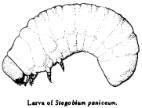Other names: Drugstore beetle, Bread beetle
Classification
Class Insecta
Order Coleoptera
Family Anobiidae
The Bread beetle, Stegobium paniceum, also known as the Biscuit beetle (or the Drugstore beetle in the U.S.A.) is one of the commonest pest insects of stored food. It is able to feed on a variety of plant and animal products including bread and flour and even hot spices and drugs. However, this beetle is not harmful to health and despite its close resemblance to the Common furniture beetle or Woodworm beetle (in the adult stage), it does not feed on wood.
Identification
The adult beetles are usually noticed first. They are small, between 2 and 4 mm in length, reddish-brown and, under magnification, reveal fine grooves running lengthways along the wing cases. Furniture beetles (or Woodworms) are similar but are somewhat larger and darker and their antennae are shorter than the legs (in Bread beetles the lengths are similar). There are three flattened segments at the tip of antennae. The head is partially hidden by the pronotum (the plate that covers the upper part of the thorax). Biscuit beetles have large dark eyes.
Dorsal view Lateral view Ventral view Biscuit (L) and Furniture beetle (R)
Photo credits: Siga / Wikimedia Commons. Line drawings © The Natural History Museum.
Possible confusion
Furniture beetle (woodworm)
Anobium punctatum
Somewhat larger and darker brown, antennae shorter than legs.
Pronotum with obvious ‘hump’ like a monk’s cowl.
Larvae bore into wood, where they feed for 3-5 years.
Photo credits: Siga / Wikimedia Commons.
Possible confusion
Cigarette beetle (Tobacco beetle)
Lasioderma serricorne
Antennae with many serrations, while Biscuit beetle has three large ones at the tip. Has much weaker punctures on the surface of the wing covers (elytra). Eyes easier to see from above. Different shape of pronotum.
Photo credits: Kamran Iftikhar / Wikimedia Commons
Distribution and habitat
The Biscuit beetle occurs in houses, stores, warehouses and kitchens throughout central and northern Europe, including the UK, sometimes in very large numbers. It is known as a cosmopolitan species.
Life cycle
In common with other beetles, this species passes through four life-stages: egg, larva, pupa and adult (pictured below). The speed of development through the life cycle depends on temperature, moisture, quality and abundance of food. In cool temperatures (below 15ºC) there is only one generation per year, in moderate temperatures two, while at higher temperatures (above 23ºC) there may be five or more.
Eggs are laid by mated females on or near the foodstuff. When the larva emerges from the egg, it is less than 1mm in length. In its search for food, it may bite into packaged or hidden food sources. The larva increases in size and, at about 5mm in length, it enters the pupal stage. Before emergence as an adult beetle, a minimum of nine days is spent as the pupa in an oval shaped cell moulded by the larva using the food material.
Damage and control
Because the Bread beetle larva thrives in dark, warm, undisturbed places, it is essential to search thoroughly for the food-source of the larva if adults are found wandering around. Rarely-used dried-foods such as flour or spices are often the source of an infestation. Removing disused and old foodstuff should eliminate an infestation.
Adult beetles may be seen around fire-places and air vents with no apparent food-source available. These are likely to have come from nests of wasps or birds in the attic. Beware also of bread in fire-places that has been dropped down the chimney by birds. With suitable hygiene, and by preventing access into the attic by nest-builders, the successful eradication of this pest should be assured.
To find out more:
Info sheet on Cornell University website:
http://idl.entomology.cornell.edu/files/2013/11/Cigarette-and-Drugstore-Beetles-2014-ocf7nv.pdf
Another info page on University of Florida Institute of Food and Agricultural Sciences:
http://entomology.ifas.ufl.edu/creatures/urban/stored/drugstore_beetle.htm









